LEE TRACY
1898–1968
 Had God, in His wisdom, decided to sculpt man from cork instead of clay, and then set this bobbing Adam down not in some suburban garden but rather in the deco concrete jungles of the Hollywood back lot, circa ’32, and had the premiere human met his maker’s stuffed-shirt, post-apple query “Where art thou?” not with stammered excuses and panicked crotch concealment but rather a flurry of fingers, stabbing and fluttering, the better to underline the insouciance of his reply (beginning “Who wants to know?”), if this had come to pass, how much happier would we, the degenerate descendants, be today—not least because this hypothetical progenitor would surely have stumped the snake on the reverse con and wrung its skin for oil?
Had God, in His wisdom, decided to sculpt man from cork instead of clay, and then set this bobbing Adam down not in some suburban garden but rather in the deco concrete jungles of the Hollywood back lot, circa ’32, and had the premiere human met his maker’s stuffed-shirt, post-apple query “Where art thou?” not with stammered excuses and panicked crotch concealment but rather a flurry of fingers, stabbing and fluttering, the better to underline the insouciance of his reply (beginning “Who wants to know?”), if this had come to pass, how much happier would we, the degenerate descendants, be today—not least because this hypothetical progenitor would surely have stumped the snake on the reverse con and wrung its skin for oil?
Yea, such a one there was, and named they him Lee Tracy. Along with Cagney, Tracy embodied the very fruit and flower of Depression American manhood, perfectly adapted to survive amidst the era’s flux of fortunes. His knobby nose, receding chin, and wheedling voice made him an unlikely leading man, but for one brief, glorious period he was: witness in wonder his turns in Blessed Event and The Half-Naked Truth (both 1932).
Tragically, his movie career arc ended in a premature splash. On a bender after wrapping his role in Viva Villa!, he peed off a hotel balcony just as a division of the Mexican army happened to be parading below. Shunted to the sidelines after the ensuing “international incident,” he scraped by in programmers for a few years (some optimist thought a film about a postal detective might spawn a series, but really) before returning to the Broadway that birthed him, where his legacy remained untainted by urine. A sad story with a happy-ish ending, for it would be hard to conceive a better final film role than the one he got, as the retiring president in 1964’s The Best Man. Iris out on the great man in ill health but conniving unto death, a paradise regained.
EUGENE PALLETTE
1889–1954
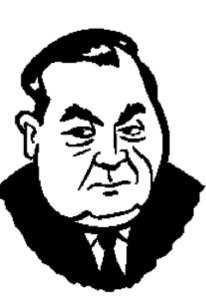 The ’30s were a great decade for the heftier player, celebrating differences of mass in a way unthinkable today, from the graceful expanse of Oliver Hardy to the walking infarction that was Eugene Pallette.
The ’30s were a great decade for the heftier player, celebrating differences of mass in a way unthinkable today, from the graceful expanse of Oliver Hardy to the walking infarction that was Eugene Pallette.
With the body of a warehouse and a basso-profundo voice that seemed to emerge, with loud echo, from somewhere beneath the floor he stood on, Pallette was often typed as wealthy capitalists, but his weight was seldom explicitly referred to. What we got instead was the perpetual umbrage machine, the tetchiness of a man who knows for certain that his waistline is about to be mentioned or at least thought about. But perhaps the pent-up fury had other causes: an extreme right-winger and, some say, a racist, Pallette in later life increasingly retreated to his own private, well-stocked fallout shelter.
Before going underground (to be reunited with his voice?) he gave us a gallery of endearing monsters in My Man Godfrey (1936), The Lady Eve (1941), and Heaven Can Wait (1943), and it’s exciting to think that, had the bomb dropped sometime in the 1950s, he might also have given us a new, subterranean human race, repopulating the nuked earth with his bellowing, elephantine sons and daughters.
NED SPARKS
1883–1957
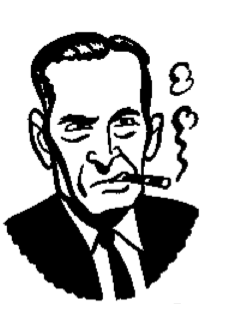 The baleful eye of Ned Sparks burns a hole through time and celluloid, straight into the soul of you, dear reader, and having inspected same, transmits its findings first to the vinegar-pickled brain of Ned Sparks, and then, in no hurry, given the sorry and unsurprising state of said soul, to his clenched and lipless mouth, which may muster at best an “Ennhh” if it does not rest content with spitting. There is no turn of events so dismal that Ned Sparks has not anticipated it, in gloomy relish. He is the scavenger penguin on the sidelines, standing stock-still by preference (unnecessary movement is the first of the vanities he shed) but sometimes forced by circumstance (a crush of bodies who have not yet learned his bitter lessons, or an extended ash on his eternally side-mouthed cigar demanding the near impossible, that he remove a hand from his pocket) to flap-foot waddle to another position, there to await one of the three inevitable outcomes for the protagonists under observation: Best, they die. Median, they go to prison (about the same as the outside world but more honest). Worst, they fall in love (in which case they should get the hell out of the way, he can wait).
The baleful eye of Ned Sparks burns a hole through time and celluloid, straight into the soul of you, dear reader, and having inspected same, transmits its findings first to the vinegar-pickled brain of Ned Sparks, and then, in no hurry, given the sorry and unsurprising state of said soul, to his clenched and lipless mouth, which may muster at best an “Ennhh” if it does not rest content with spitting. There is no turn of events so dismal that Ned Sparks has not anticipated it, in gloomy relish. He is the scavenger penguin on the sidelines, standing stock-still by preference (unnecessary movement is the first of the vanities he shed) but sometimes forced by circumstance (a crush of bodies who have not yet learned his bitter lessons, or an extended ash on his eternally side-mouthed cigar demanding the near impossible, that he remove a hand from his pocket) to flap-foot waddle to another position, there to await one of the three inevitable outcomes for the protagonists under observation: Best, they die. Median, they go to prison (about the same as the outside world but more honest). Worst, they fall in love (in which case they should get the hell out of the way, he can wait).
ERNEST THESIGER
1879–1961
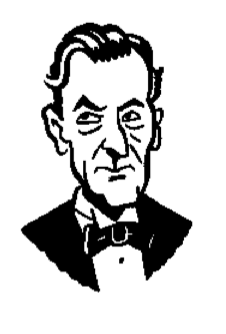 Ernest Thesiger belongs, almost, to an unofficial group of effete English actors who created a parody of the upper classes and worked extensively with their nostrils. Noel Coward and Kenneth Williams were working-class boys who studied thespian poshness and created their own extreme versions of it (in Williams’s case, lapsing back to cockney in mid-sentence for comic effect), but Thesiger, the grandson of a baron, was the thing itself.
Ernest Thesiger belongs, almost, to an unofficial group of effete English actors who created a parody of the upper classes and worked extensively with their nostrils. Noel Coward and Kenneth Williams were working-class boys who studied thespian poshness and created their own extreme versions of it (in Williams’s case, lapsing back to cockney in mid-sentence for comic effect), but Thesiger, the grandson of a baron, was the thing itself.
With his freshly exhumed appearance, high-church air of disdain (equine flaring of the nose), and frankly homosexual manner, Thesiger had some trouble fitting in—H. G. Wells objected to his performance in 1936’s Things to Come and had him replaced, and his military exhortations in Caesar and Cleopatra (1945) provoked hilarity among the extras—but James Whale used him memorably in The Old Dark House (1932) and Bride of Frankenstein (1935), where he and his nostrils could be as Against Nature as they liked.
WARREN WILLIAM
1894–1948
 The Profile of Warren William, a Roman bust of bone and skin, was remarkable indeed, yet seemingly somewhat used. Compared to the yet more illustrious profile of J. Barrymore (itself showing signs of wear by the ’30s), the William phiz couldn’t help but seem a knockoff, a forgery from more dubious material.
The Profile of Warren William, a Roman bust of bone and skin, was remarkable indeed, yet seemingly somewhat used. Compared to the yet more illustrious profile of J. Barrymore (itself showing signs of wear by the ’30s), the William phiz couldn’t help but seem a knockoff, a forgery from more dubious material.
Few better exemplified the peculiar knowingness of the pre-code era (though he met his match in the preternaturally sleazy Ricardo Cortez, who, even in his occasional ventures as romantic lead, seemed to clutch a hidden knife). With his eyes forever clouded in the aftermath of an orgy too many, his crumbling gilt frame around a core of solid jade, how perfectly he would have suited Sade. But that adaptation remains confined to our dreams or nightmares, if it doesn’t survive moldering beneath the paving stones of some old magnate’s mansion. We will note instead his strange turn as the detective in Satan Met a Lady, 1936’s comic variation of The Maltese Falcon. In William’s treatment, the character is much less like the unsentimental shamus we know from Hammett and much more like The Laughing Cavalier. Laughter is indeed the defining feature of his interpretation—it’s a miracle he ever solves a case, what with all that laughing. This carries over to the rest of the cast. Everyone seems drunk.
LIONEL STANDER
1908–94
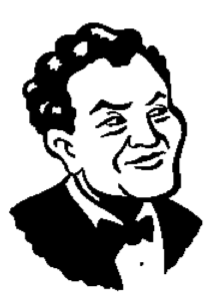 Lionel. Stander. What grand images of surliness those two words conjure up! Those who remember him as the surprisingly proletarian butler Max in TV’s Hart to Hart (“helping to lobotomize the entire world,” as the actor put it) are often surprised by the robust, energetic, malformed figure cut by Stander in films like Mr. Deeds Goes to Town or The Milky Way, both 1936.
Lionel. Stander. What grand images of surliness those two words conjure up! Those who remember him as the surprisingly proletarian butler Max in TV’s Hart to Hart (“helping to lobotomize the entire world,” as the actor put it) are often surprised by the robust, energetic, malformed figure cut by Stander in films like Mr. Deeds Goes to Town or The Milky Way, both 1936.
With the thickest Bronx accent permissible by law, encrusted by a voice that sounds like the grinding of tectonic plates, Stander embodied—what, exactly? The enthusiasm of his age for the grotesque and special, perhaps, or the respect accorded to the hustler, the ebullient and abrasive go-getter, even if what he was going and getting was illegal or degenerate. So winning is Stander in the 1937 A Star Is Born that he effaces the real nature of his role, the embodiment of the heartless Hollywood publicity machine. The shockingly callous joke he makes in response to a protagonist’s death is delivered with such plebeian panache that we can’t help but chuckle, monstrously.
All this was accomplished while the great man was officially unemployable: Stander was a blacklisted commie long before it became fashionable. Fans of the Marx brothers’ brand of comedy should check out his testimony before HUAC. But he was still grabbing work from independent studios and friendly directors who appreciated the extra production values Stander brought with his Neanderthal slope-brow, prognathous jaw, and tiny fist of nose.
ALLEN JENKINS
1900–74
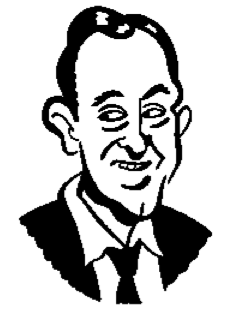 An amiable urban earthworm fluent in New York demotic (“wotta goil,” “wotta woild”), Jenkins was but one of the known quantities that made even routine Warner Bros. films of the period so much less of a drag than, say, the standard studio product of our own, so much more like a zippy visit with extended (and possibly more colorful and endearing) family. (I mention, in passing, our rallying cry: “Warners forever! MGM hardly ever!”) Appearing not too variously as a succession of Lefties, Louies, Spudsies, Droopies, Mugsies, Willie the Knifes, and Ed the Weasels, he set the tinhorn tintype for unthreatening thugs, lackluster lackies, and stoic, quasi-competent working stiffs. Slue-footed and ill-shoed for the race of existence, he takes his place under the sign of eternity with a throwaway scene from 1934’s I’ve Got Your Number. Louise Beavers scans his palm for signs of life: “It appears to me that you is in the path of a lot of calamity. And your death line looks awful short. Look like trouble all over your hand.” Moans Jenkins, “Ohhh, Crystal—ain’t my luck ever gonna change?” It will not.
An amiable urban earthworm fluent in New York demotic (“wotta goil,” “wotta woild”), Jenkins was but one of the known quantities that made even routine Warner Bros. films of the period so much less of a drag than, say, the standard studio product of our own, so much more like a zippy visit with extended (and possibly more colorful and endearing) family. (I mention, in passing, our rallying cry: “Warners forever! MGM hardly ever!”) Appearing not too variously as a succession of Lefties, Louies, Spudsies, Droopies, Mugsies, Willie the Knifes, and Ed the Weasels, he set the tinhorn tintype for unthreatening thugs, lackluster lackies, and stoic, quasi-competent working stiffs. Slue-footed and ill-shoed for the race of existence, he takes his place under the sign of eternity with a throwaway scene from 1934’s I’ve Got Your Number. Louise Beavers scans his palm for signs of life: “It appears to me that you is in the path of a lot of calamity. And your death line looks awful short. Look like trouble all over your hand.” Moans Jenkins, “Ohhh, Crystal—ain’t my luck ever gonna change?” It will not.
MISCHA AUER
1905–67
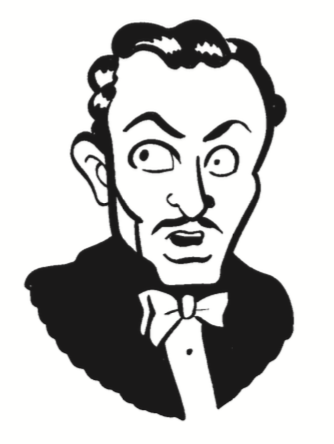 It’s very strange. First there was no Mischa Auer to speak of, though there was an actor by that name. In Sucker Money, 1933, there’s a blurry hole where the lead heavy should be. By 1936 and My Man Godfrey, Auer’s Russian accent has mysteriously grown much stronger and he has acquired that invaluable commodity, a persona.
It’s very strange. First there was no Mischa Auer to speak of, though there was an actor by that name. In Sucker Money, 1933, there’s a blurry hole where the lead heavy should be. By 1936 and My Man Godfrey, Auer’s Russian accent has mysteriously grown much stronger and he has acquired that invaluable commodity, a persona.
Through some occult process, the Mad Russian Persona, developed by Auer and deployed by him to such great comic effect in a long succession of eccentric comedies (You Can’t Take It with You, 1938) and adventure capers (Destry Rides Again, 1939), was accompanied by a physical transmogrification that gave rise to a new and more interesting appearance, complementing the MRP in delightful and unexpected ways. While other “comedy foreigners” were running variations on swarthy and rotund, Auer became a limpid skeleton, his huge, baleful, and watery eyes peering from the shadows of a skull the shape of a leg, decorated with a slender mustache and a towering, equine nose. This gaudy creation sat atop a scarecrow physique that appeared, rather than to support the head, to dangle from it.
EDWARD EVERETT HORTON
1886–1970
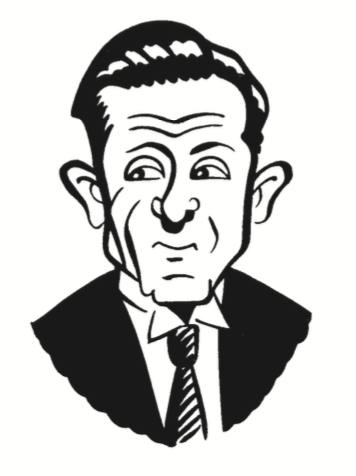 Edward Everett, are you gay? Or are you just extremely nervous? The question alone is enough to draw the echt-E.E.H. premature nod of assent followed by the increasingly apprehensive double-, triple-, quadruple-take (can he go for five?) that Horton kept in flighty trim in over sixty films during the 1930s. The field at that time was not lacking in pansies (the eternal Pangborn springs first to mind), but Horton brought something different to the stereotype: a certain desperation, a sense of the ineluctably trapped.
Edward Everett, are you gay? Or are you just extremely nervous? The question alone is enough to draw the echt-E.E.H. premature nod of assent followed by the increasingly apprehensive double-, triple-, quadruple-take (can he go for five?) that Horton kept in flighty trim in over sixty films during the 1930s. The field at that time was not lacking in pansies (the eternal Pangborn springs first to mind), but Horton brought something different to the stereotype: a certain desperation, a sense of the ineluctably trapped.
See him now, mouth perpetually pinched into quivering moues of distress at the approach of predatory females, who flock round in surprising abundance, for there appears to be something irresistible to the breed in this heavily powdered slab of man-meat. Perhaps they love a challenge.
But the Horton universe is not exclusively defined by fear and loathing. There is joy, too. Witness his fatuous bliss during the supremely idiotic (and implicitly painful) “Let’s K-nock K-nees” number in The Gay Divorcee (1934). And in an earlier scene in the same film, as he performs a happy two-step for fingers with a little dancing-girl puppet strapped to his hand, perhaps we glimpse his secret. This thick and lumbering man wishes he were a dainty ballerina. The dream comes crashing down again with the inevitable entrance of yet another pursuing female: “Oh, Egbert! I didn’t know you liked dolls!”
GRADY SUTTON
1906–95
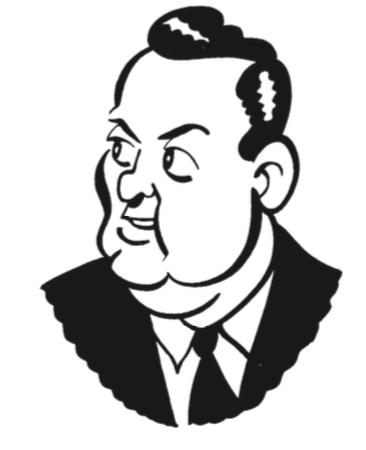 “The age of chivalry is dead; this is the age of chiselry,” lectures Jimmy Cagney in Blonde Crazy. Of course, any era like the ’30s (go ahead, name one) must balance its tricksters and vamps with a victim class, a clown army of chumps awaiting fleecing, but a populace drunk on Groucho could never be satisfied with any ordinary dope, the kind born every minute. They demanded, and rightly, that Hollywood must and should provide unique and startling specimens of homo sap, from Guy Kibbee (obese rodent, shaved and perspiring) to Billy Gilbert (bursting chimp, eyes like frightened marbles jammed in a heap of dough). And so, to add to the wondrous variety, a mild butterball was born, and they called it Grady Sutton.
“The age of chivalry is dead; this is the age of chiselry,” lectures Jimmy Cagney in Blonde Crazy. Of course, any era like the ’30s (go ahead, name one) must balance its tricksters and vamps with a victim class, a clown army of chumps awaiting fleecing, but a populace drunk on Groucho could never be satisfied with any ordinary dope, the kind born every minute. They demanded, and rightly, that Hollywood must and should provide unique and startling specimens of homo sap, from Guy Kibbee (obese rodent, shaved and perspiring) to Billy Gilbert (bursting chimp, eyes like frightened marbles jammed in a heap of dough). And so, to add to the wondrous variety, a mild butterball was born, and they called it Grady Sutton.
An ambulatory baby whose hapless, infant puss could on occasion reveal a certain low vegetable cunning, Sutton exemplified the schmo, the schnook, the schlub, but made those figures somehow magnetic. He can’t enter a scene without giving it a burst of, not energy, certainly not that, but a certain paradoxically fascinating inertia. He slows the pace down and makes you interested. He’s an enjoyable drag.
In his fifty-odd years as underrated prodigy, his gentle Tennessee twang and plump snail’s face were associated with talents like W. C. Fields (The Bank Dick, 1940), Barbara Stanwyck (The Mad Miss Manton, 1938), and, at the far end, Raquel Welch (Myra Breckinridge, 1970), in roles that ran the gamut from second to fifteenth banana. And in every one he fulfilled the requirement we have of the great bit-part actor: he could play anything, yet was always the same.
—D. Cairns and B. Kite




